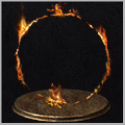Part 4: - Undead Settlement Part 1



Okay, I could get this done sooner than expected. Turns out my project files and everything else for the LP could be recovered from my dead PC. (Even if it weren't, I at least saved the footage elsewhere so it would have been some editing and commentating that needed to be redone. Thankfully, I don't have to!)
Storytelling in Souls Games
I don't want to get into the actual story and plot of the games. Rather I'd like to talk a bit about the presentation. For all it's worth the plot of Dark Souls wouldn't be anything special if it were presented in a more conventional manner with cutscenes feeding the player new information or audio and text logs about events and characters. In fairness, the item descriptions are basically text logs, though, in a very abridged form which makes it feel very different. There will be a lot of times where we have just enough information to make an educated guess about what's going on, but not enough to absolutely confirm anything. I was theorizing a bit near the beginning of the video, for instance, but none of it is confirmed anyway. In fact, I may be completely off.
Item descriptions is only one of the three big aspects of how the story of a souls game is presented to the player. There's also NPCs and The environments themselves often tell stories as well. There's a lot of care put into the level designs. There will be plenty of details that can give you clues on upcoming gameplay challenges, obviously. See scorched ground? Better look out for some dragon swooping down.
But there's also bits and pieces that drive the story or give you an idea about the history of a place. Aside from the actual environments you will also find items in specific spots and their descriptions may give you some insight on the area you're going through. Perhaps there's specific enemies? Maybe there's an NPC nearby too? I consider all those parts of the environment. And this is where it may all come together. Let's take the story of Lautrec from Dark Souls, for instance.
We're entering a church. The bottom level has an altar with a Firekeeper's Soul on it. Eventually you discover Lautrec imprisoned in the upper level of the church, since you ahve the key anyway you let him out, what could possibly go wrong? I mean, he seems a bit off, has a sick laugh and all that. But all the other NPCs have that as well. He even gives you a bit of a reward for rescuing him if you return to Firelink Shrine and talk to him. where he hangs out near the Fire Keeper.
Time passes and you return to Firelink Shrine to find that the bonfire has been extinguished and can't be used anymore. You notice that Lautrec is gone and the Firekeeper is dead. Then next time you meet Lautrec he's in Anor Londo, another area with a fire keeper. After you kill him he drops the Soul of the Fire Keeper from Firelink Shrine. Even though you may not catch on to these clues your first time around or even on a second run, they are definitely there and you could figure out that Lautrec just wanders around to kill Firekeepers. If you read descriptions to items relating to Lautrec you can find out that he does so out of some twisted love for the goddess he worships.
And you might not even question why he's imprisoned but this is where a whole new layer comes into this. Because why was he even imprisoned? Hollows don't take prisoners. The only one in the entire game who does is Seath. And there's a couple of enemies specifically linked to Seath, like the Crystal Golems, you can find near where Dusk is imprisoned. Or the Channelers, who explicitly kidnap people for Seath. One of the Channelers can be found in the Undead Church where Lautrec is held. Was he maybe stored in that cell to be transferred to Seath's Archives later for his experiments? If you Rescue Rhea from the bottom of the Tomb of Giants she will also go to that church... and later still will show up in Seath's Archives.
Dark Souls II seemed to focus a bit more on the gameplay aspect but that doesn't mean that it's devoid of that kind of storytelling, though, a lot of it boils down to "vague vague vague, ending item description with a question?" it still has its moments. Dark Souls III returns to form a bit but there's not too much we can talk about in that regard at this point.
It probably all comes from Hidetaka Miyazaki, the director of All Souls games except for Dark Souls II (where he was merely supervising), reading English novels despite not speaking English all that well. There were a lot of parts that he couldn't understand, so he filled in the blanks himself. A lot of the time he found that what he came up with was way cooler than what was actually written in the stories he liked to read. And that's where the "Tell some, let them guess the rest" approach comes from.